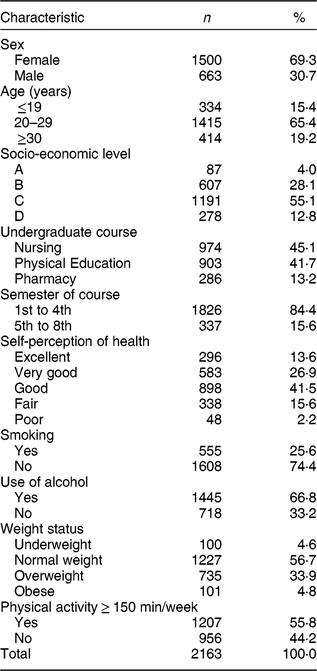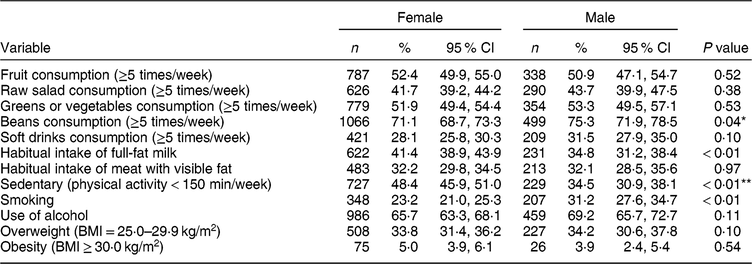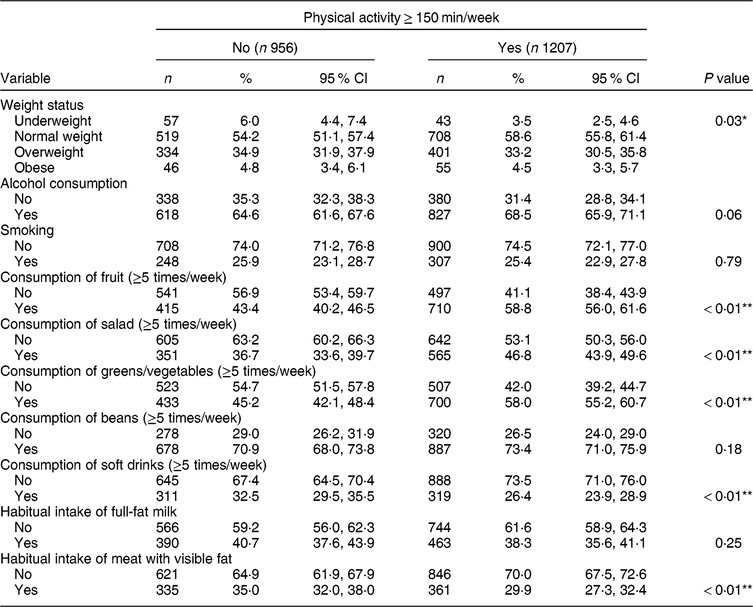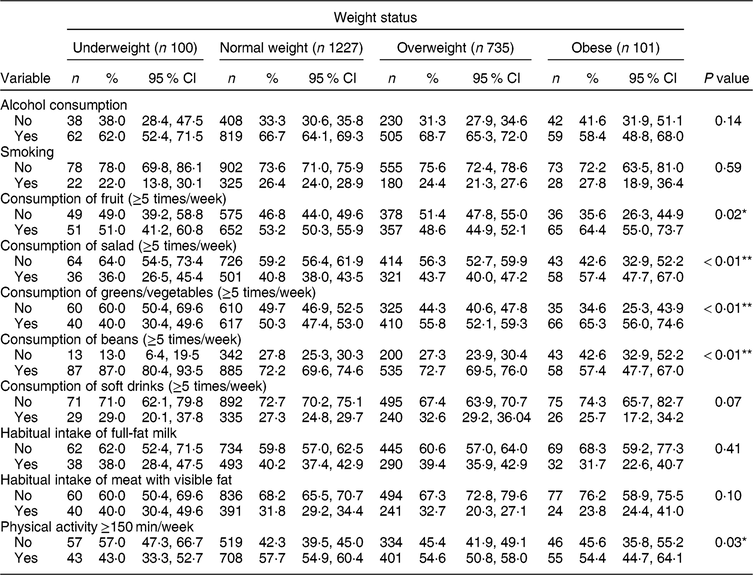The Western lifestyle has changed the dietary habits and lifestyle pattern of young students in developing countries, which is leading them to develop overweight and obesity and consequently be more prone to develop type 2 diabetes mellitus and CVD( Reference Ibrahim, Mahnashi and Al-Dhahri 1 ). A study reported substantial correlations between junk food intake and screen time( Reference Al-Hazzaa, Al-Sobayel and Abahussain 2 ). A study in Brazil reported a positive relationship between physical activity and increased intake of vegetables and fruits, whereas watching television was linked to an increased consumption of fried food( Reference Pires, Mussi and Cerqueira 3 ).
Studies carried out in Brazil have demonstrated that the lifestyle profile of university students presents worrying deficiencies in respect to physical activity and eating habits( Reference Pires, Mussi and Cerqueira 3 ). Lifestyle has a significant impact on the health of individuals. In a study carried out with university students, it was found that risk behaviours adopted by the students were unhealthy eating habits, having excess weight and consuming alcoholic beverages( Reference Faria, GandolfI and Moura 4 ).
The transition from high school to university is a critical period for changes to occur in dietary habits, lifestyle and weight gain( Reference Musaiger, Hammad and Tayyem 5 ). Several studies in developing and developed countries have shown that dietary behaviours of university students are poor, with low intakes of milk, fruit and vegetables, and high intake of foods rich in fat and carbohydrates( Reference Peltzer and Pengpid 6 ). University student populations are widely reported to engage in high rates of physical inactivity, sedentary behaviours and unhealthy dietary behaviours including skipping meals, inadequate snacking, high consumption of fast foods and insufficient consumption of fruits and vegetables( Reference Thorpe, Kestin and Riddell 7 ).
A focus on strengthening protective factors and earlier investment in prevention of non-communicable diseases among young people, and particularly university students, are therefore essential. In this respect, in university students aged 18–24 years, the establishment of healthy lifestyle behaviours, including healthy eating, may have a lasting impact on the health of these individuals and consequently on the health of their future families( Reference Fernandez, Singru and Kshirsagar 8 ).
Having the proper dietary habits, undertaking sufficient physical activity and tackling overweight and obesity are fundamental aspects of the prophylactic ways of ensuring health, which includes the prevention of CVD( Reference Basu, Sarkar and Shahbabu 9 ). Therefore, data on the dietary and lifestyle patterns of young people are needed for any intervention programme aimed at promoting healthy food habits and lifestyle among the young population. Thus, the present study aimed to assess weight status and eating habits of undergraduate university students in relation to gender and examine the relationships between weight status, physical activity and eating habits.
Methods
Study design and sample
The present cross-sectional epidemiological study was conducted among undergraduate students majoring in health care (Nursing, Physical Education and Pharmacy) at a private institution in Brasilia, Brazil.
A convenience sample, consisting of 2163 undergraduate students (who were aged 18 years or older) out of the total of 2468 students enrolled in the programme during the academic year of 2016, were included in the study. The loss of 305 students, representing 12·4 % of the population, is because students did not attend the university on the day of data collection. A second attempt to include the students who missed the first day of data collection was made during another day. If the student missed both opportunities, he/she was not included in the study.
The study population was composed of first to eighth-semester students who were in their classrooms on the day of data collection. Most participants were women (69·3 %), 65·4 % were aged 20–29 years, 66·8 % used alcohol and 44·2 % did not achieve 150 min or more of physical activity per week.
The number of participants was defined based on the guidelines on simple random sampling provided by Luiz and Magnanini( Reference Luiz and Magnanini 10 ). The number of students per course was taken into consideration for sample size calculation. The maximum tolerable error rate was 5 % and the 95 % confidence levels were indicated. We assumed a 50 % prevalence for the outcome. Thus, the final sample consisted of 974 undergraduate Nursing students, 903 undergraduate Physical Education students and 286 undergraduate Pharmacy students.
Measures
Data collection was performed between October 2016 and May 2017 by trained researchers. The instrument was administered during the break between lessons, in a classroom with a seating capacity for sixty students. The completed questionnaire was placed in an envelope containing the group name and the course session (morning, afternoon or evening) and handed back to the researchers.
Before distributing the instrument for self-completion and the informed consent form for signing, the researchers briefly introduced themselves and explained the aims and methods of the study to the professor in charge of the particular class. Next, the researchers introduced themselves and the study project to the students and invited them to participate. The informed consent of each participant, as well as the authorization and the required ethical approval of the Centro Universitário do Distrito Federal, were obtained (protocol number 1.794.275).
We used a self-administered questionnaire on health-related lifestyle habits. All questions were obtained from the Surveillance of Risk and Protection Factors for Chronic Diseases through Telephone Interviews (Vigilância de Fatores de Risco e Proteção para Doenças Crônicas por Inquérito Telefônico (VIGITEL))( Reference Brasil 11 ). The questionnaire monitored the main risk and protective factors for non-communicable chronic diseases among adults older than 18 years and is applied on an annual and continuous basis in all Brazilian states and the Federal District( Reference Brasil 11 ).
Sociodemographic characteristics
The following demographic variables were included in the analysis: gender (male or female); age; socio-economic level (based on the questionnaire of the Brazilian Association of Research Companies)( 12 ); alcohol consumption (heavy drinking was defined as the consumption of five or more drinks in one sitting for men and four or more drinks in one sitting for women); smoking (yes/no); and health self-perception (excellent, very good, good, fair or poor).
Assessment of dietary habits
Food consumption was assessed using healthy and unhealthy diet markers according to the nomenclature used in VIGITEL( Reference Brasil 11 ). Regular consumption of fruits and vegetables (≥5 d/week), recommended consumption of fruits and vegetables (consumption of 5 servings/d on ≥5 d/week) and regular consumption of beans (≥5 d/week) were considered healthy diet markers.
Unhealthy diet markers included habitual intake of meat with excess fat (red meat with apparent fat and chicken with skin), habitual intake of full-fat milk and regular consumption of soft drinks or powdered drink mix/artificial juice (≥5 d/week).
Assessment of weight status
Weight status was assessed by calculating BMI (weight in kilograms divided by the square of height in metres). Self-reported weight and height, as well as cut-off points, were used in the calculation. Participants were classified as underweight (BMI < 18·5 kg/m2), normal weight (BMI = 18·5–24·9 kg/m2), overweight (BMI = 25·0–29·9 kg/m2) or obese (BMI ≥ 30·0 kg/m2)( 13 ).
Physical activity
Level of physical activity was classified as inactive (less than 150 min of moderate-intensity physical activity per week or less than 75 min of vigorous-intensity physical activity per week accumulated across work, home, transport or discretionary domains) or active (150 min or more of moderate-intensity physical activity per week). The WHO( 14 ) has recommended that adults aged 18–64 years should do at least 150 min of moderate-intensity physical activity per week.
Analyses
Data are presented as absolute and relative frequencies, and displayed with their respective 95 % CI. Gender differences and the association between physical activity and nutritional status and eating habits were analysed using χ 2 tests. The association between nutritional status and the remaining variables was analysed using χ 2 tests.
A multiple correspondence analysis was conducted to test the joint relationship between nutritional status, gender, physical activity and eating habits. All statistical analyses were performed using the statistical software package SAS version 9.2, while the multiple correspondence analysis was conducted using the statistical software package IBM SPSS Statistics version 21. The level of significance was set at 5 %.
Results
Table 1 shows participants’ sociodemographic characteristics and health-related lifestyle behaviours.
Table 1 Description of the sample of undergraduate university students (n 2163) majoring in health care, Brasília, Brasília, FD, Brazil, 2017

Table 2 shows gender differences in eating habits, smoking, alcohol consumption, physical activity and weight status (overweight and obesity). There were significant differences in beans (P < 0·04) and full-fat milk consumption (P < 0·01) between men and women. Men were found to smoke more (P < 0·01) compared with women. Although prevalence of alcohol use was higher among men (69·2 %), there was no difference in alcohol consumption between the two groups. Women were found to be more sedentary (P < 0·01) and showed a higher prevalence of overweight (33·8 %) and obesity (5·0 %) than men.
Table 2 Comparison of eating habits, smoking, alcohol consumption, physical activity and weight status by gender in the sample of undergraduate university students (n 2163) majoring in health care, Brasília, DF, Brazil, 2017

* P < 0·05,
** P < 0·01.
Table 3 shows the association between physical activity and health-related lifestyle habits. Students who did not achieve the recommended level of physical activity (150 min or more per week) were found to be more overweight (P = 0·03). Physically active participants consumed more fruit (P < 0·01), salad (P < 0·01) and greens/vegetables (P < 0·01), whereas physically inactive participants consumed more soft drinks (P < 0·01) and meat with visible fat (P = 0·01). These findings demonstrate that physically active individuals tend to have healthier lifestyles than their physically inactive peers.
Table 3 Association between physical activity participation and health-related lifestyle habits in the sample of undergraduate university students (n 2163) majoring in health care, Brasília, DF, Brazil, 2017

* P < 0·05,
** P < 0·01.
There was a positive association between weight status and fruit (P = 0·02), salad (P < 0·01), greens/vegetables (P < 0·01) and beans (P < 0·01) intake. Physical activity was found to be associated with weight status (Table 4).
Table 4 Association between weight status and health-related lifestyle habits in the sample of undergraduate university students (n 2163) majoring in health care, Brasília, DF, Brazil, 2017

* P < 0·05,
** P < 0·01.
Figure 1 shows the joint relationship between eating habits, weight status and physical activity, as assessed by multiple correspondence analyses. For this data set, there was only 29·6 % explanation in two dimensions (sum of dimensions 1 and 2). Figure 1 indicates that underweight participants consumed meat with visible fat, full-fat milk and soft drinks, while obese participants did not consume full-fat milk, meat with visible fat, beans and soft drinks. This is probably due to dietary re-education. Physically active individuals (150 min or more per week) tended to regularly consume greens/vegetables, fruit and salad, whereas their physically inactive counterparts did not consume these foods regularly.

Fig. 1 Joint relationship between eating habits, weight status and physical activity of the sample of undergraduate university students (n 2163) majoring in health care, Brasília, DF, Brazil, 2017. ![]() , achieves 150 min or more of physical activity per week;
, achieves 150 min or more of physical activity per week; ![]() , consumes beans ≥ 5 times/week;
, consumes beans ≥ 5 times/week; ![]() , consumes fruit ≥ 5 times/week;
, consumes fruit ≥ 5 times/week; ![]() , consumes salad ≥ 5 times/week;
, consumes salad ≥ 5 times/week; ![]() , consumes soft drinks ≥ 5 times/week;
, consumes soft drinks ≥ 5 times/week; ![]() , consumes greens/vegetables ≥ 5 times/week;
, consumes greens/vegetables ≥ 5 times/week; ![]() , habitual intake of full-fat milk;
, habitual intake of full-fat milk; ![]() habitual intake of meat with visible fat;
habitual intake of meat with visible fat; ![]() , gender;
, gender; ![]() , nutritional status.
, nutritional status.
Discussion
The present study is the first to assess weight status, eating habits and physical activity among a large sample of university undergraduate students in Brasilia (Midwest Brazil). Interventions promoting a healthy and active lifestyle – especially those carried out in the university setting – can play an important role in the prevention and management of overweight and obesity in young adults( Reference Sira and Pawlak 15 ).
Assessment of BMI based on self-reported weight and height showed that most participants were in the healthy weight category (56·7 %). However, the percentages of undergraduates who had above-normal BMI values (33·9 % overweight and 4·8 % obesity) were higher than those found in other Brazilian studies( Reference Gunes, Bekiroglu and Imeryuz 16 ). Factors that may be associated with excess weight, as measured by the BMI, are poor dietary habits and low levels of physical activity( Reference Gatti, Pegoraro and Kevicz 17 ).
Other studies with undergraduate students from different countries have also found high prevalence of overweight and obesity( Reference Peltzer, Pengpid and Samuels 18 ). A study conducted with university students in Greece( Reference Deliens, Clarys and Bourdeaudhuij 19 ) showed that 34·4 % of men and 19·9 % of women were overweight, while 5·1 % of men and 3·4 % of women were obese. In Turkey, 6·0 % of men were obese, while 25·1 % of men and 5·6 % of women were overweight( Reference Khan, Assir and Shafiq 20 ). In Pakistan, the majority of university students were normal weight, 37 % were overweight and about 9 % were obese( Reference Khan, Jameel and Khalil 21 ). In Spain, 12·4 % were underweight, 79·2 % were normal weight and 8·4 % were overweight or obese( Reference Lopez, Santa Teresa and Saez Crespo 22 ).
Some studies suggest that nutritional inadequacies are common among undergraduate students, because their dietary habits are strongly influenced by factors such as university admission, lack of time to have full meals due to university activities, replacement of full meals by snacks, establishment of new behaviours and new social relations. These factors influence overweight and self-image disparity( Reference Monteiro, Andrade and Zanirati 23 ).
Brazilian studies show that the consumption of fruits and greens/vegetables by university students is below the recommended daily intake for this population group( Reference Rombaldi, Silva and Neutzling 24 ). Frequency of fruit and vegetable consumption among university students has been widely investigated in Brazil and internationally( Reference Louzada, Martins and Canella 25, Reference De Piero, Bassett and Rossi 26 ). Recent studies show that regular intake of fruits and greens/vegetables increased between 2008 (33·0 %) and 2016 (35·2 %). However, consumption levels are still below the recommended levels for a healthy diet that prevents non-communicable chronic diseases( 27, 28 ).
A study conducted among undergraduate medical students in Northern Italy found that 73·4 % of their daily diet consisted of foods rich in fats, while 13·1 % were fast foods( Reference Lupi, Bagordo and Stefanati 29 ). The percentage of students who consumed fruits and greens/vegetables was 76·6 and 8·3 %, respectively( Reference Lupi, Bagordo and Stefanati 29 ). These findings indicate that university students have poor dietary habits and corroborate the concern about this transition phase from adolescence to adulthood, when healthy dietary habits are established( Reference Hadjimbei, Botsaris and Gekas 30 ).
A study in Jeddah reported that 73·4 % of the students were eating foods rich in fat and 13·1 % were eating fast food daily, while the majority of the students (76·6 %) ate fruits and 38·3 % ate vegetables weekly( Reference El-Kassas, Itani and Zeina 31 ). A study conducted with university students in Leon (Spain) and Bologna (Italy) showed that both groups consumed more fat and less vegetables than the recommended daily portions( Reference Poínhos, Alves and Vieira 32 ). This leads to a high incidence of overweight and evidences eating habits that are not consistent with the Mediterranean dietary tradition, which is rich is fruits, fish, grains and greens/vegetables( Reference Poínhos, Alves and Vieira 32 ). These results were attributed to changes in dietary patterns, which are very common during university years( Reference Poínhos, Alves and Vieira 32 ).
The present study is in line with other national and international research that shows a high prevalence of physical inactivity among young people( Reference Cureau, Silva and Bloch 33 ). In the present study, more than half of the sample was classified as sedentary (56·4 %). Bergier et al.( Reference Bergier, Bergier and Ninikowska 34 ) in found that 49·7 % of about 2500 undergraduate students from the Czech Republic, Poland, Slovakia and Hungary undertook less than 150 min of physical activity per week. Gasparotto et al.( Reference Gasparotto, Gasparotto and Salles 35 ) also found that about 55 % of undergraduate students in the fields of Biological and Exact Sciences and Humanities undertook less than 150 min of physical activity per week. Nevertheless, a study conducted among university health-care students found a disturbing reality: most participants (65·5 %) self-reported being sedentary( Reference Oliveira, Gordia and Quadros 36 ). High levels of sedentary lifestyle were also found in a study with university students in the USA: 46 % of participants were physically inactive or irregularly active( Reference Harris, Gee and D’Acquisio 37 ). Generally, fewer females achieve the physical activity recommendations: in Mexico and Hong Kong, male university students were physically more active/exercised more frequently( Reference Díez and Pérez-Fortis 38 ).
Thus, the increase of regular physical activity participation during university attendance may have a positive impact on current and future health, due to the possibility of these individuals becoming more active adults( Reference Dinger, Brittain and Hutchinson 39 ). University is a place where students learn, work, socialize, spend their leisure time and make use of health services( Reference Griffiths, Kouvonen and Pentti 40 ). Therefore, policies are needed to enable the provision of spaces and alternatives for physical activity participation and healthier lifestyles in educational settings.
The present study has a number of limitations. First, the cross-sectional nature of the data analysed impedes indicating any causal relationship or direct influence of the variables included in the study. Second, the data on physical activity and diet were collected using a self-reported questionnaire, which might have caused measurement errors in the estimation of the prevalence (over-reporting in the case of healthy habits or under-reporting in the case of unhealthy habits, as previously reported in literature). Finally, regarding dietary information, consumption of each of the selected foods was collected based on frequency per week without portion size.
Conclusion
In conclusion, the present study described eating and physical activity habits of a sample of Brazilian undergraduate university students. From both a dietary and physical activity perspective, the habits of the young adults surveyed in the present study were not consistent with a healthy lifestyle and the prevention of non-communicable diseases in adulthood. A joint effort between universities and all relevant government agencies is needed in order to develop school- and community-based interventions that promote physical activity and healthy eating practices among young Brazilian adults.
Acknowledgements
Financial support: This research received no specific grant from any funding agency in the public, commercial for not-for-profit sectors. Conflict of interest: None. Authorship: L.Z.M. made substantial contributions to conception and design, data acquisition, analysis and interpretation, and final approval of the version to be published. A.R.V. contributed to drafting the article, revising it critically for important intellectual content and final approval of the version to be published. B.A.L., L.C.C., M.L.A.C. and P.S. contributed to data acquisition, analysis and interpretation. J.O.T.N. and F.B.J. contributed to data acquisition, drafting the article and revising it critically for important intellectual content. Ethics of human subject participation: This study was conducted according to the guidelines laid down in the Declaration of Helsinki and all procedures involving human subjects were approved by the Research Ethics Committee of the University Center of the Federal District (protocol number 1.794.275). Written informed consent was obtained from all subjects.
Author ORCID
Luciana Zaranza Monteiro, 0000-0001-7484-1185.







